BMC FootPrints v12 Integration
Functionality of the Integration
- When an incident is created in BMC FootPrints v12, an alert will be created in Opsgenie.
- When an incident is updated in BMC FootPrints v12, a note will be added to the alert in Opsgenie.
- When an incident is resolved in BMC FootPrints v12, the alert will be closed in Opsgenie.
- When a problem is created in BMC FootPrints v12, an alert will be created in Opsgenie.
- When a problem is updated in BMC FootPrints v12, a note will be added to the alert in Opsgenie.
- When a problem is resolved in BMC FootPrints v12, the alert will be closed in Opsgenie.
- When an alert is created in Opsgenie, an incident or a problem will be created in BMC FootPrints v12.
- When a note is added to the alert in Opsgenie, the incident or the problem will be updated in BMC FootPrints v12.
- When the priority of the alert is changed in Opsgenie, the priority of the incident or the problem will be updated in BMC FootPrints v12.
- When the alert is closed in Opsgenie, the incident or the problem will be resolved in BMC FootPrints v12.
Add BMC FootPrints v12 Integration in Opsgenie
- Please create an Opsgenie account, if you haven't done already.
- Go to Opsgenie BMC FootPrints v12 Integration page.
- Specify who should be notified for BMC FootPrints v12 alerts using the "Teams" field. Auto-complete suggestions will be provided as you type.
- Copy the API key by clicking on the copy button or selecting.
- Click on "Save Integration".
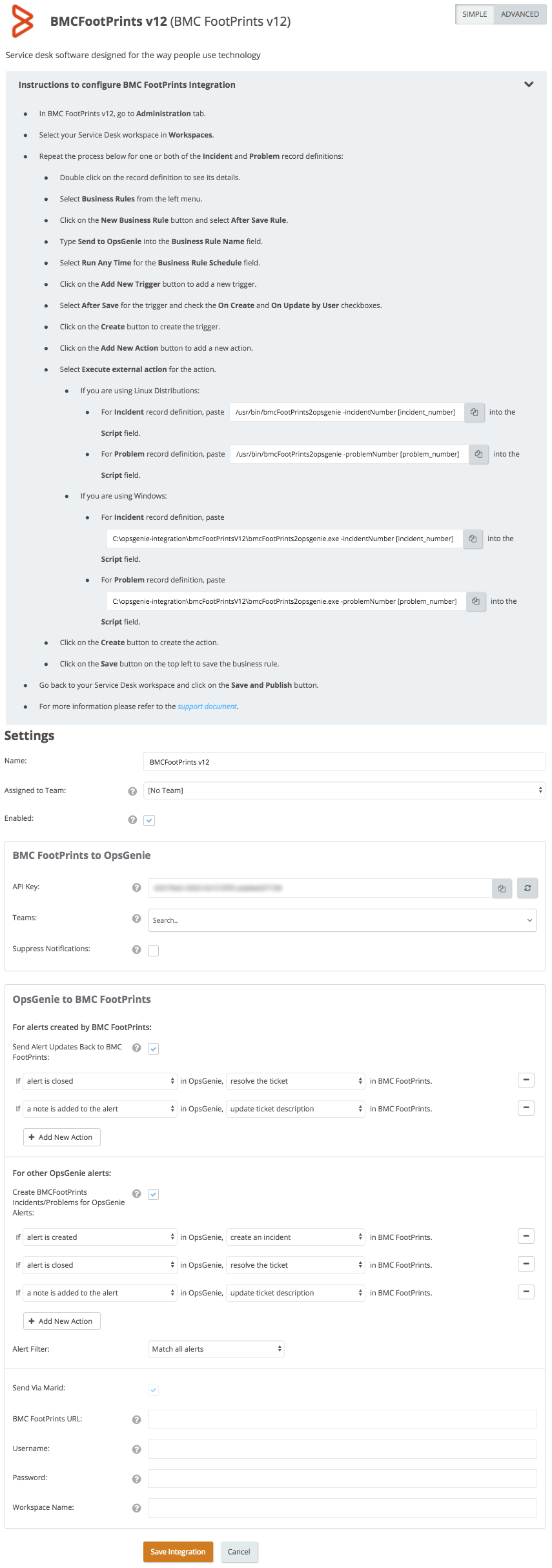
Configuration in BMC FootPrints v12
- In BMC FootPrints v12, go to Administration tab.
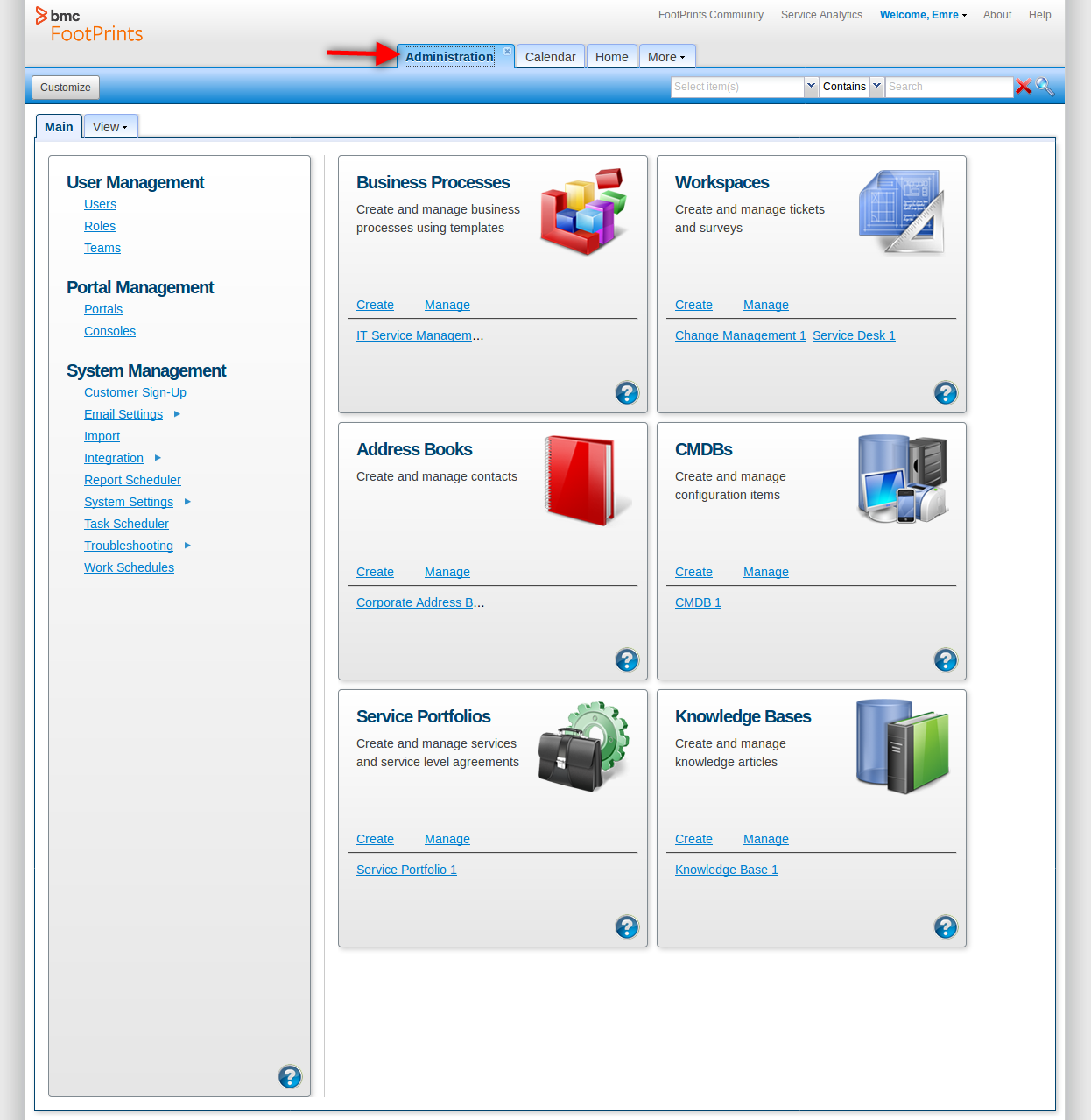
- Select your Service Desk workspace in Workspaces.
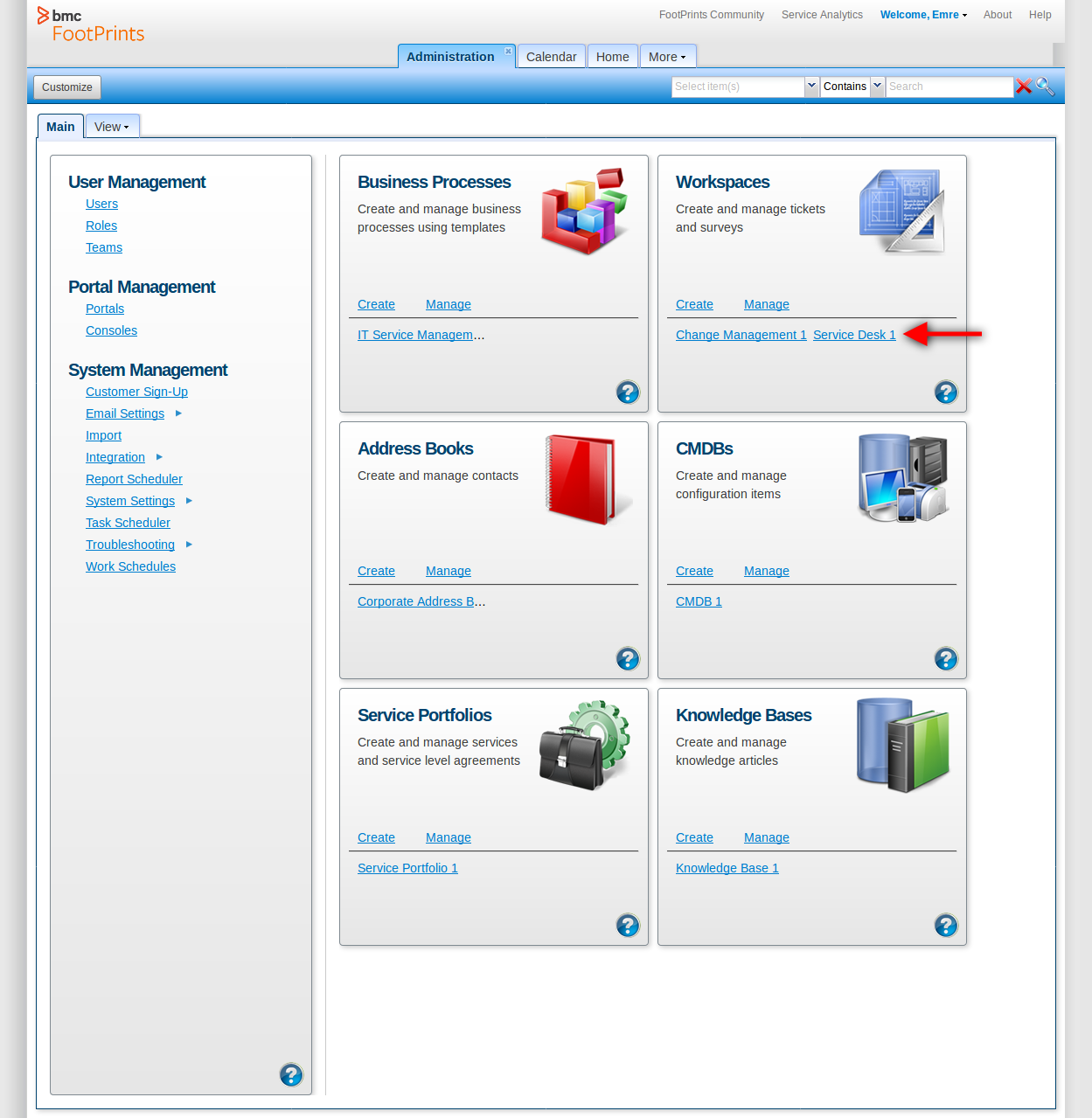
- Repeat the process below for one or both of the Incident and Problem record definitions:
- Double click on the record definition to see its details.
- Select Fields from the left menu.
- Click on the Add button to add a new field, and then select Add Field.
- Name the field as Opsgenie Alert Alias. This name should be exactly the same since Opsgenie uses this name to access the field from the API.
- Select Simple Text as the Field Type.
- Select Hidden as the Permissions.
- Click on the Save button to save the field.
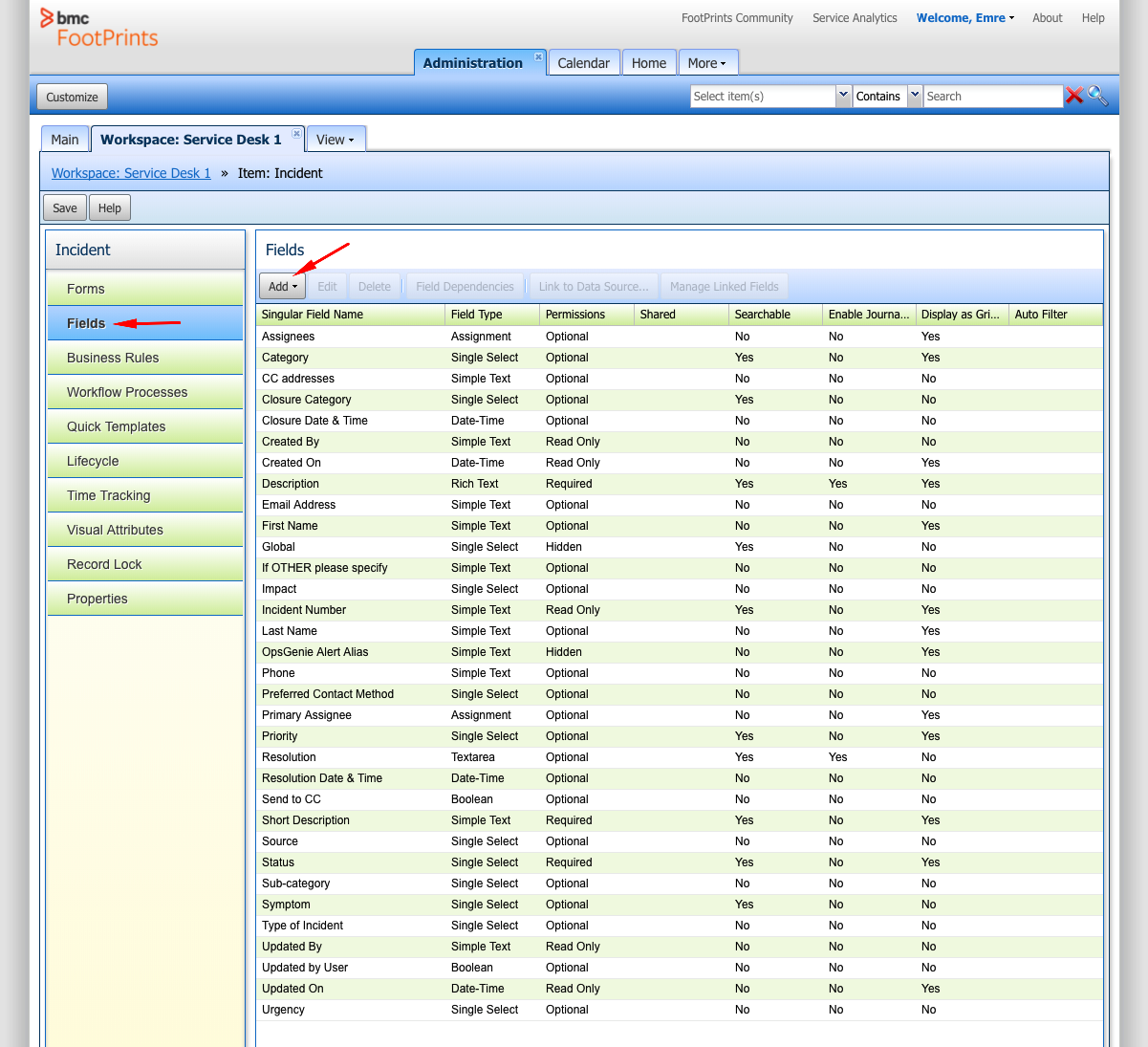
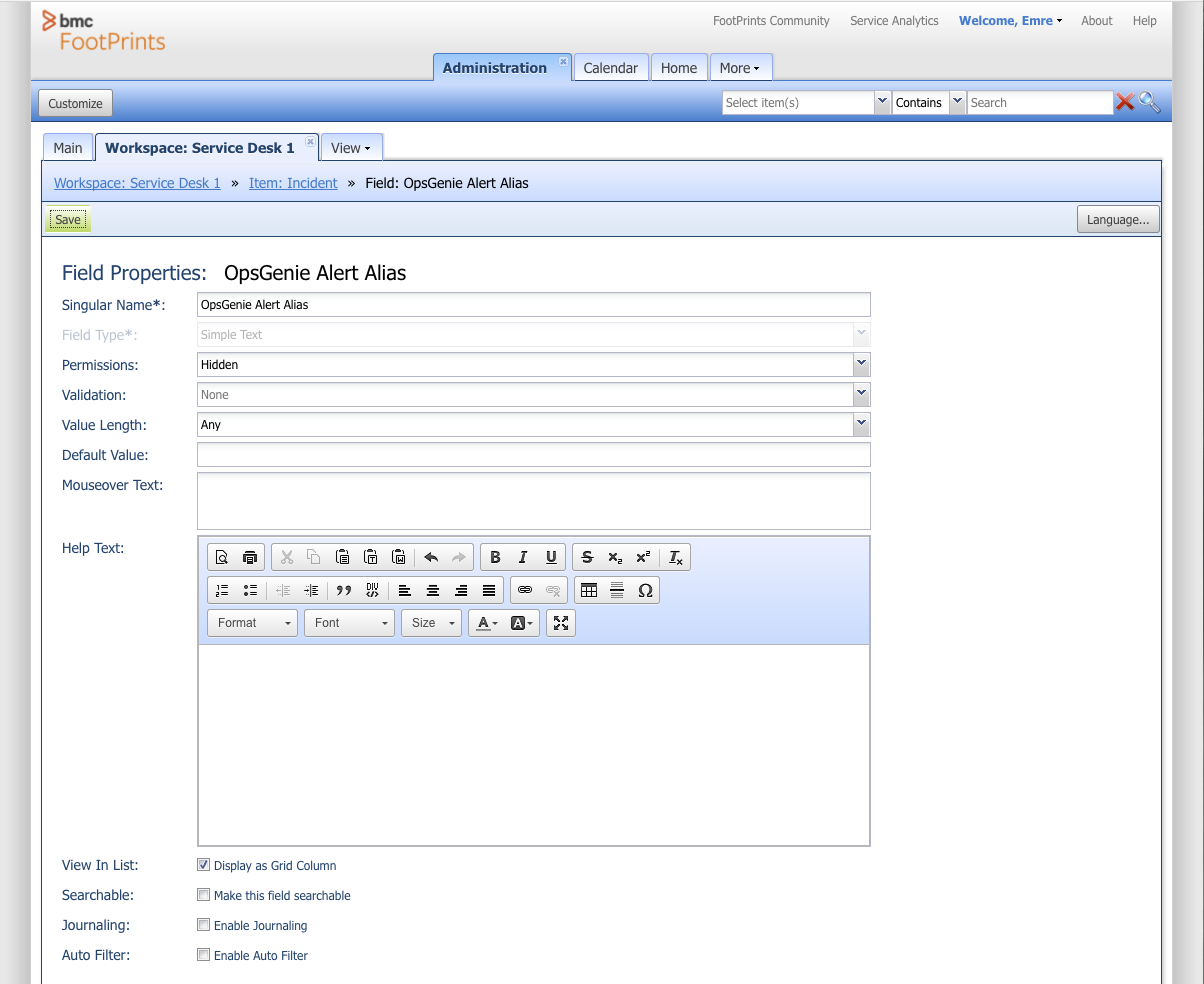
-
- Go back to the record definition again, and this time select Business Rules from the left menu.
- Click on the New Business Rule button and select After Save Rule.
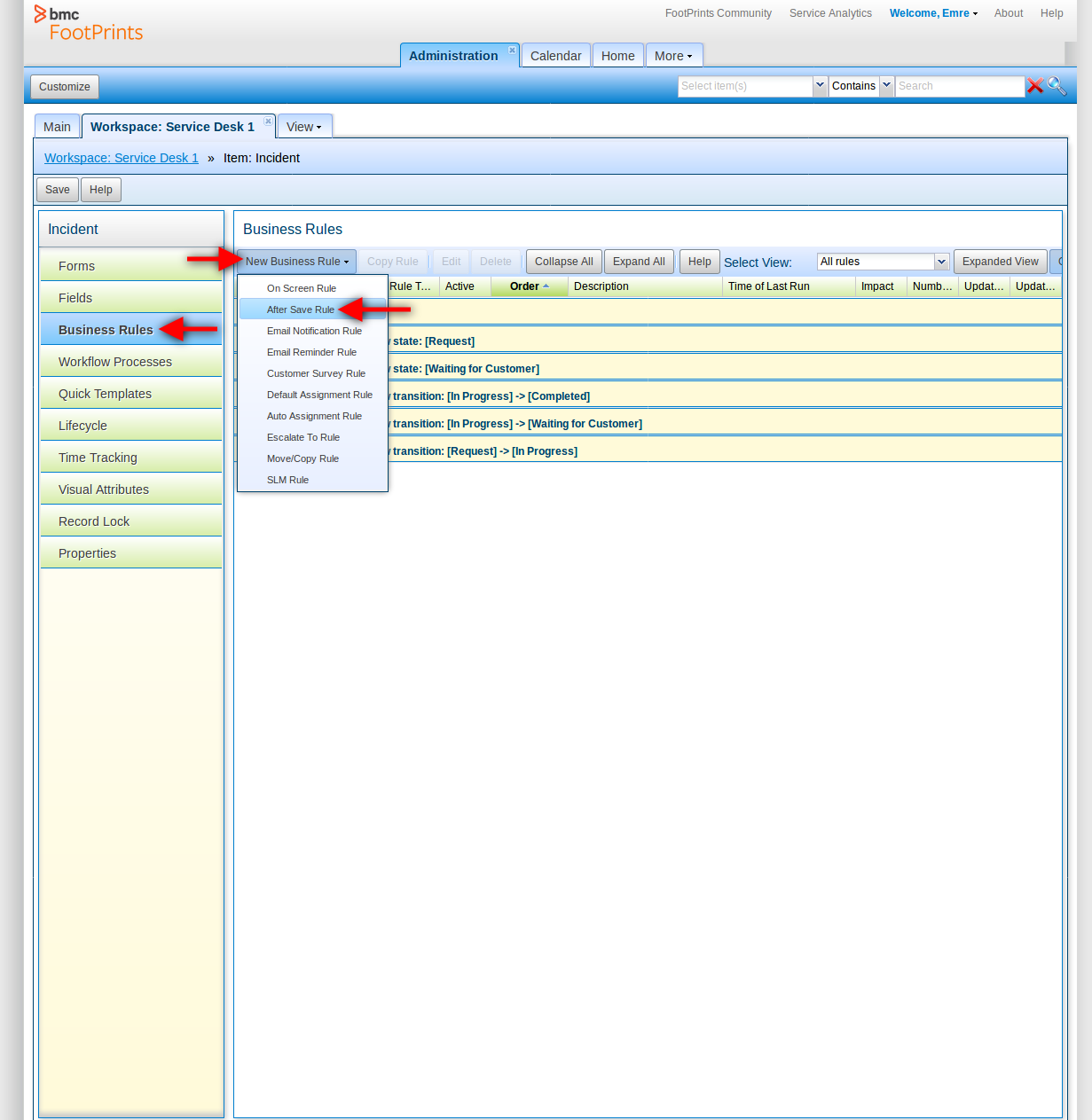
-
- Type Send to Opsgenie into the Business Rule Name field.
- Select Run Any Time for the Business Rule Schedule field.
- Click on the Add New Trigger button to add a new trigger.
- Select After Save for the trigger and check the On Create and On Update by User checkboxes.
- Click on the Create button to create the trigger.
- Click on the Add New Action button to add a new action.
- Select Execute external action for the action.
- If you are using Linux Distributions:
- For Incident record definition, paste
/usr/bin/bmcFootPrints2opsgenie -incidentNumber [incident_number] - For Problem record definition, paste
/usr/bin/bmcFootPrints2opsgenie -problemNumber [problem_number]
- For Incident record definition, paste
- If you are using Windows:
- For Incident record definition, paste
C:\opsgenie-integration\bmcFootPrintsV12\bmcFootPrints2opsgenie.exe -incidentNumber [incident_number] - For Problem record definition, paste
C:\opsgenie-integration\bmcFootPrintsV12\bmcFootPrints2opsgenie.exe -problemNumber [problem_number]
- For Incident record definition, paste
- If you are using Linux Distributions:
- Click on the Create button to create the action.
- Click on the Save button on the top left to save the business rule.
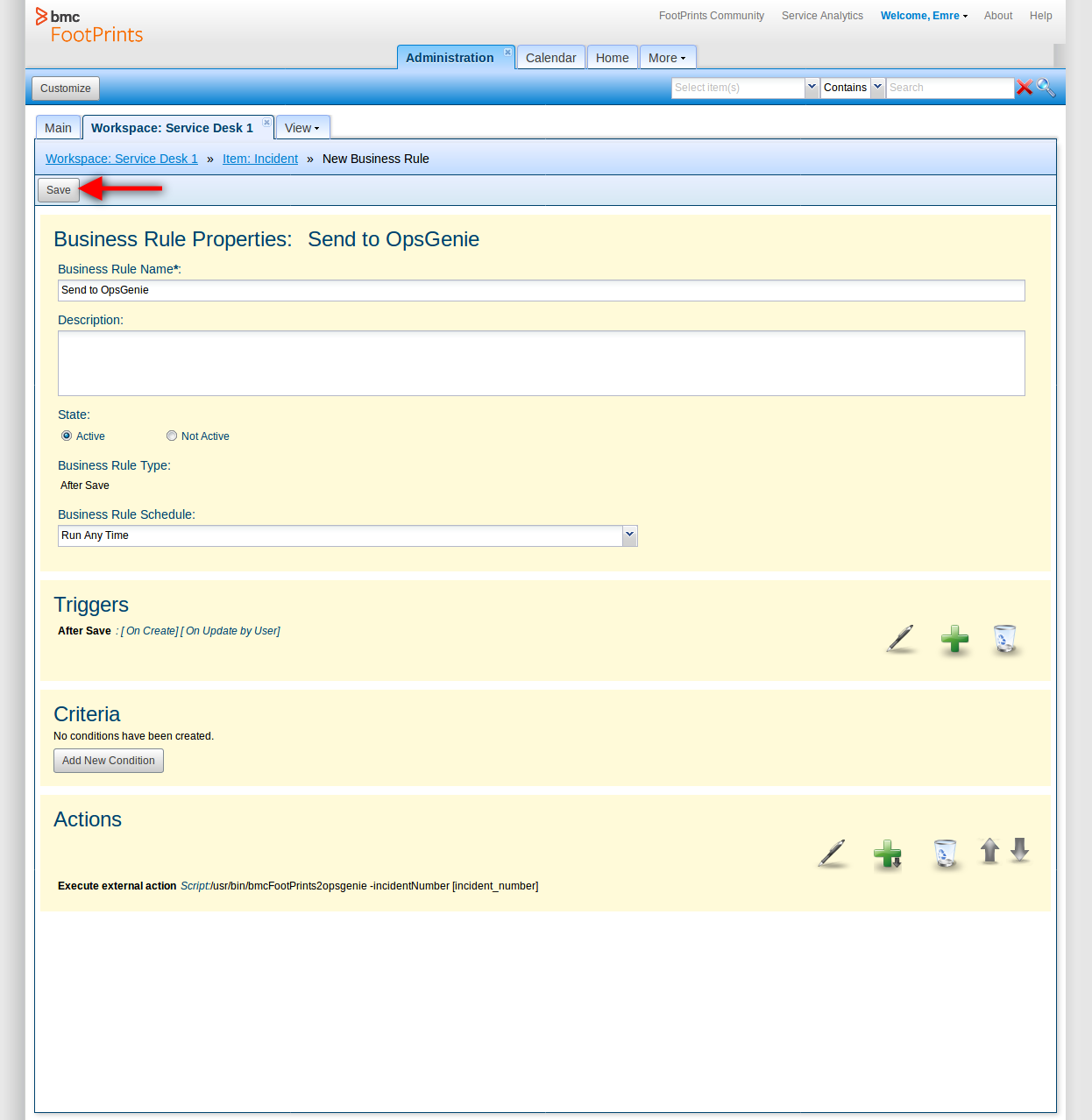
- Go back to your Service Desk workspace and click on the Save and Publish button.
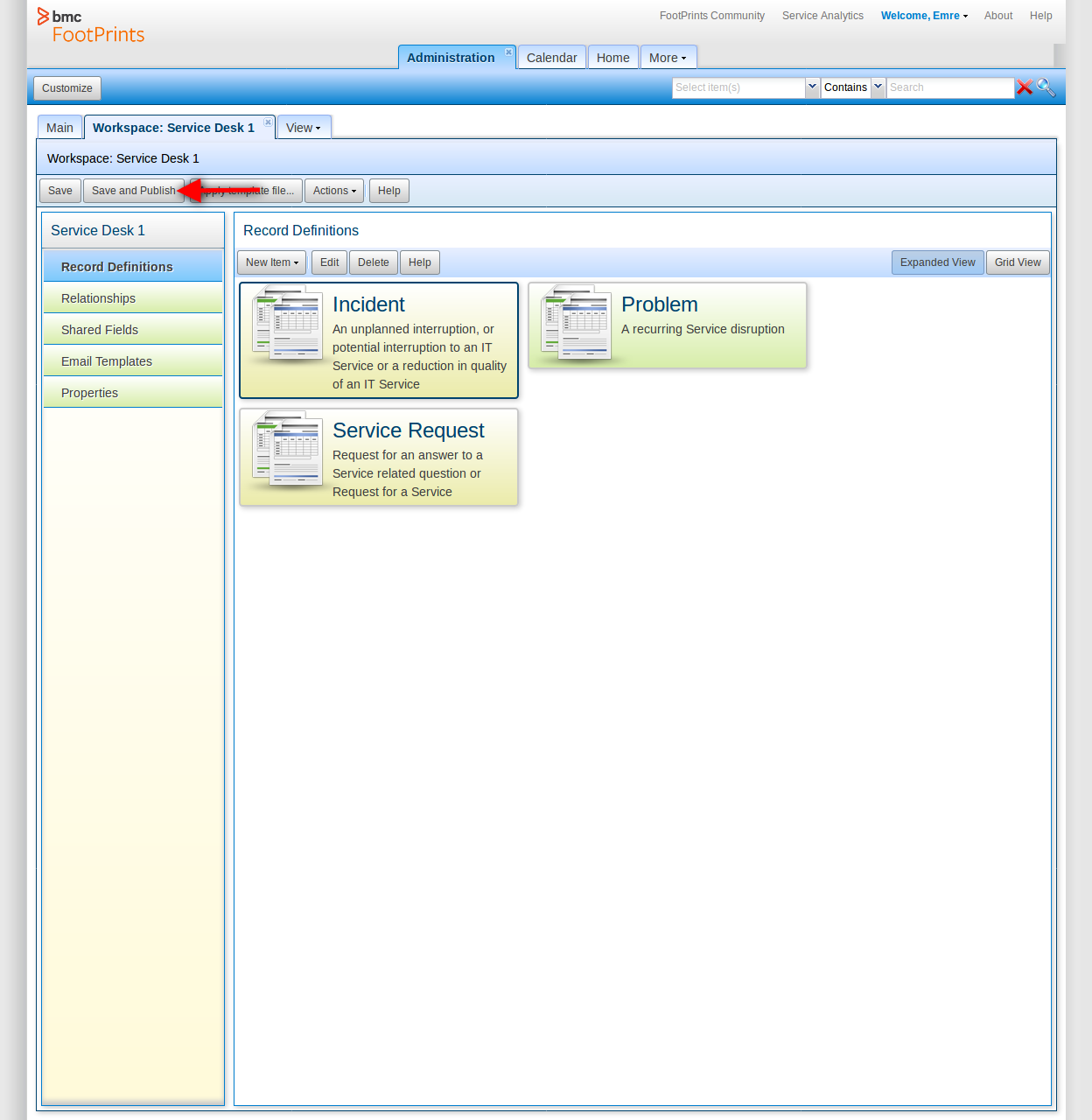
Integration via Marid
You can use Opsgenie's BMC FootPrints v12 integration package to create/update/resolve incidents or problems in BMC FootPrints v12. This will enable you to deploy your own scripts / modify the ones provided and execute customized actions on BMC FootPrints v12.
To use BMC FootPrints v12 integration package, you need to follow the steps in the sections below through the end.
In order to use this feature, "Create BMCFootPrints Incidents/Problems for Opsgenie Alerts" checkbox should be enabled in Opsgenie BMC FootPrints v12 integration configuration page.
Download and install BMC FootPrints v12 package
For Red Hat Based Distributions
- Download Opsgenie BMC FootPrints v12 (Linux RPM)
- Run the following command :
rpm -i opsgenie-bmcfootprints-v12-<your_version>.rpm
During upgrades, rpm package does not overwrite your existing configurations. It saves the new default configuration file as opsgenie-integration.conf.rpmnew. You can find more information about rpm upgrade config file handling from here.
For Debian Based Distributions
- Download Opsgenie BMC FootPrints v12 (Linux DEB)
- Run the following command :
dpkg -i opsgenie-bmcfootprints-v12_<your_version>.deb
For Windows
- Download Opsgenie BMC FootPrints v12
- Unzip opsgenie integration zip file which contains Marid package into a directory (C:\opsgenie-integration is the preferred path. C:\opsgenie-integration\marid will be referred as MARID_HOME in the rest of documentation.)
- To install Marid as a service:
- Open a command window
- Go to <MARID_HOME> directory
- For 32 bit systems, run marid.exe -install
- For 64 bit systems, run marid_64.exe -install
- Name of the service will be assigned to "OpsGenie Marid"
To set JAVA_HOME environment variable, refer to Setting JAVA_HOME for more information.
To enable Ruby scripting, you need to download JRuby Complete jar file and put this jar file in lib directory (/var/lib/opsgenie/marid On Linux, MARID_HOME/lib on Windows systems.).
You may need to restart your system after setting JAVA_HOME environment variable for Windows XP/2000/2003 operating systems due to problem reported at **http://support.microsoft.com/kb/821761
Configuring BMC FootPrints v12 Integration for Marid
If you are using Opsgenie Edge Connector instead of Marid, you can find the integration specific script and its sample config from here. For more information about OEC, please refer OEC Integration documentation
- Configurations regarding BMC FootPrints v12 can be done either via integration page or Marid configuration file opsgenie-integration.conf. The configuration in the integration page will precede the configuration file.
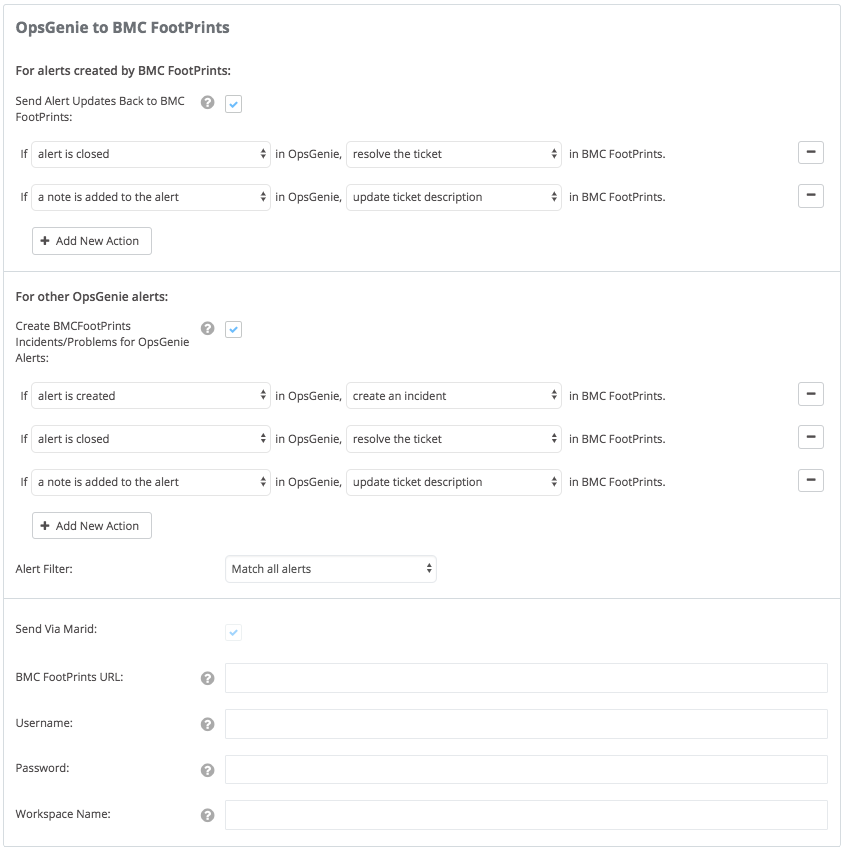
Marid Configuration
The integration uses Marid utility (included in the package) to create/update/resolve incidents/problems in BMC FootPrints v12 when alerts are updated in Opsgenie.
To start Marid, Open Command Prompt
- For Windows:
- Go to <MARID_HOME> directory and run the following command.
- For 32 bit systems:
marid.exe -start - For 64 bit systems:
marid_64.exe -start
- For Linux:
sudo /etc/init.d/marid start
To stop Marid, run the following command:
- For Windows:
- Go to <MARID_HOME> directory and run the following command.
- For 32 bit systems:
marid.exe -stop - For 64 bit systems:
marid_64.exe -stop
- For Linux:
sudo /etc/init.d/marid stop
To be able to execute actions in BMC FootPrints v12, Marid gets the configuration parameters from C:/opsgenie-integration/conf/opsgenie-integration.conf file in Windows and /etc/opsgenie/conf/opsgenie-integration.conf file in Linux.
Configuration Parameters | |
|---|---|
apiKey | Copy the API key from the BMC FootPrints v12 integration you've created above. |
logPath | Specifies the full path of the log file for bmcFootPrints2opsgenie. (Default value is /var/log/opsgenie/bmcFootPrints2opsgenie.log for Linux and C:\opsgenie-integration\bmcFootPrints2opsgenie.log for Windows.) |
bmcFootPrints2opsgenie.logger | Specifies the log level for bmcFootPrints2opsgenie. (Default value is warning) |
bmcFootPrints.url | URL of your BMC FootPrints v12 instance. |
bmcFootPrints.username | Username of your BMC FootPrints v12 user for authentication. |
bmcFootPrints.password | Password of your BMC FootPrints v12 user for authentication. |
bmcFootPrints.workspaceName | Name of your service desk workspace in BMC FootPrints v12. (E.g. Service Desk 1) |
bmcFootPrints2opsgenie.http.proxy.enabled | bmcFootPrints2opsgenie.http.proxy.enabled field is to enable/disable external proxy configuration. The default value is false. |
bmcFootPrints2opsgenie.http.proxy.host | It is the host of the proxy. |
bmcFootPrints2opsgenie.http.proxy.port | It is the port of the proxy. |
bmcFootPrints2opsgenie.http.proxy.protocol | It is the proxy connection protocol. It may be http or https depending on your proxy servers. Its default value is http. |
bmcFootPrints2opsgenie.http.proxy.username | It is the Proxy authentication username. |
bmcFootPrints2opsgenie.http.proxy.password | It is the Proxy authentication password. |
opsgenie.api.url | If you're using OpsGenie from another domain(eg. EU, sandbox), you should update this configuration. |
According to the action that will be executed in BMC FootPrints v12, the script to be run can be set here. Opsgenie's script is set by default; you can change the following configuration to run your own custom script if you like.
Action Mapping | Script File |
|---|---|
mappedActions.createIncident.script | bmcFootPrintsActionExecutor.groovy |
mappedActions.createProblem.script | bmcFootPrintsActionExecutor.groovy |
mappedActions.updateDescription.script | bmcFootPrintsActionExecutor.groovy |
mappedActions.updatePriority.script | bmcFootPrintsActionExecutor.groovy |
mappedActions.resolveTicket.script | bmcFootPrintsActionExecutor.groovy |
Sample parameters sent to Marid
{
"type": "bmcFootPrintsV12",
"alertId": "ccec1231-9cbf-468c-a6ce-c52a18712404",
"customerId": "c32f2305-f7ad-4fed-8d85-2f3cae411983",
"action": "Create",
"mappedActionV2": {
"name": "createIncident",
"extraField": ""
},
"integrationId": "5769475e-ddc6-4978-812e-50ed2aab9a5b",
"integrationName": "BMCFootPrints v12",
"integrationType": "BMCFootPrintsV12",
"sendViaMarid": true,
"url": "",
"username": "",
"password": "",
"workspaceName": "",
"shortDescription": "Test message.",
"priority": "P3",
"description": "[Opsgenie] Test description."
}Updated 7 months ago
